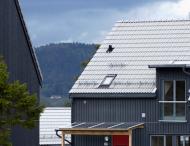Sustainable construction
As urbanization increases, the demand for housing and infrastructures also grows. However, buildings account for important CO2 emissions and consume huge amounts of energy across a lifecycle that spans production, construction, operation and demolition.
The challenge is to continue to build but to do so in a different way. Lafarge is committed to sustainable construction and works in partnership with other players to develop new construction methods.
The challenges of sustainable construction |
|
|
Sustainable construction addresses two major global challenges: the significant environmental impact of the construction industry, balanced against the industry's economic and social benefits.
Sustainable construction addresses both challenges by limiting the environmental and human impact of construction while guaranteeing the highest quality in aesthetics, strength and durability. It considers the complete life cycle of a building, from the selection of materials to demolition and recycling. |

Challenges addressed by sustainable constructionSustainable construction addresses two major global challenges:
Sustainable developmentThe World Commission on Environment and Development defines sustainable development as "development that meets the needs of the present without compromising the ability of future generations to meet their own needs". Sustainable development aims to reconcile 3 major stakes:
Sustainable buildings: not as expensive as they seem! Results of a W.B.C.S.D study This is the conclusion of a study carried out in the context of the "Energy Efficient Buildings" project, co-managed by Lafarge and part of the W.B.C.S.D. This misunderstanding is a major obstacle to the construction of environmentally-friendly buildings. Sustainable developmentThe World Commission on Environment and Development defines sustainable development as "development that meets the needs of the present without compromising the ability of future generations to meet their own needs". Sustainable development aims to reconcile 3 major stakes:
environmental aspects (achieving a balance between a company's activities and the preservation of ecosystems). Sustainable buildings: not as expensive as they seem! Results of a W.B.C.S.D study This is the conclusion of a study carried out in the context of the "Energy Efficient Buildings" project, co-managed by Lafarge and part of the W.B.C.S.D. This misunderstanding is a major obstacle to the construction of environmentally-friendly buildings. |
What is sustainable construction |
|
|
In practice, sustainable construction means:
|
|
Putting sustainable construction into practice |
|
|
Lafarge Egypt is taking practical steps to make sustainable construction a reality. |
|
Putting sustainable construction into practice |
|
|
Lafarge Egypt is taking practical steps to make sustainable construction a reality. |
|





